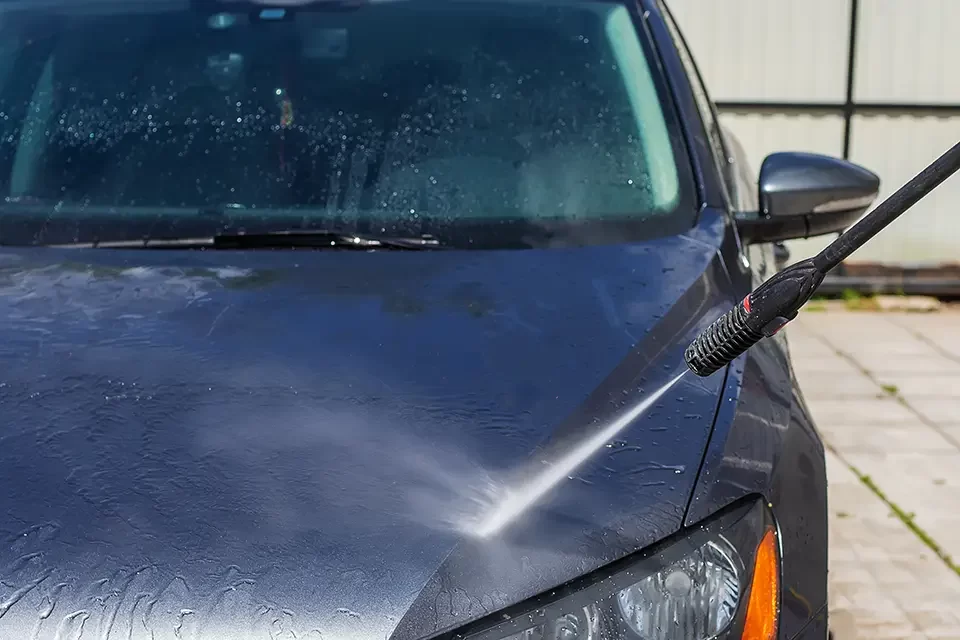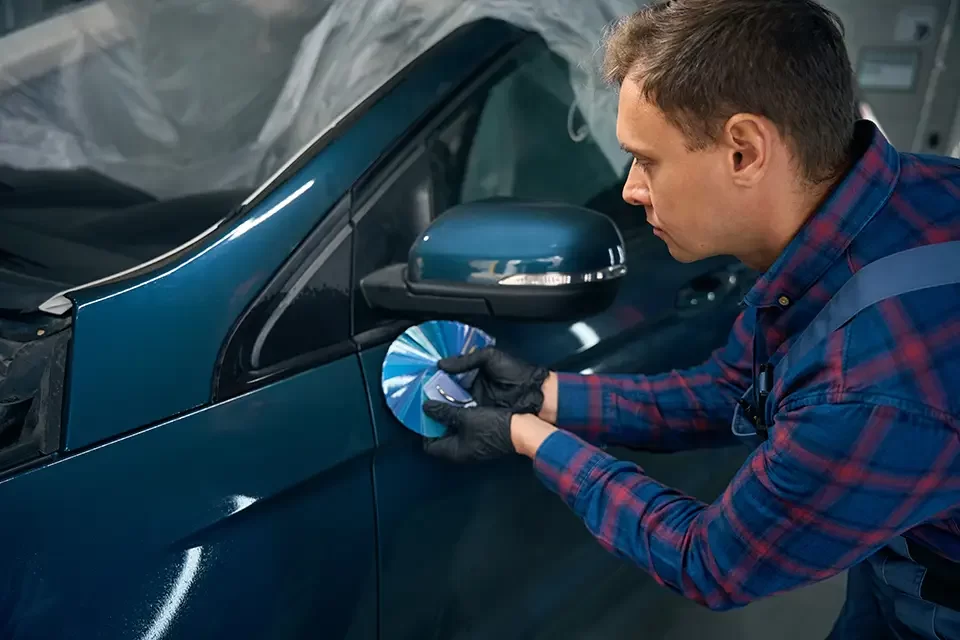Some colours look good on the lot and even better on the road. Deep blue is one of them. It carries some of the presence of black without the harshness, and it stays more interesting than a standard grey. But choosing dark blue paint for cars (or repairing it after a scrape) asks a few smart questions first: which finish, how to match, how to protect, and what it really takes to keep it looking deep, glossy, and clean. At Auto Stars Collision & Mechanic in Richmond Hill, Ontario, we see the same pattern—owners love the look, then discover the care routine and the difference a precise refinish makes. This guide is the no-spin version: what to expect, where your money actually goes, and how to keep that mirror-like navy looking new.
Dark Blue Paint for Cars: Why Drivers Choose It
Dark blue paint for cars carry a refined, understated look in daylight and a dramatic shine under evening lights. It’s also a shade that flatters most body lines, from sedans to SUVs.
- Visual tone: Deep blues read premium without shouting. They hide dust better than black but still reward a wash with a rich gloss.
- Design versatility: Works with chrome or satin trim, bright or smoked lamps, and both light and dark wheel finishes.
- Timeless appeal: Trends shift; classic navy rarely does.
That’s why dark blue paint for cars has stayed popular across models and model years—subtle by day, striking at night.
Finish Choices: Metallic, Pearl, or Solid
The same colour can look very different depending on how it’s built. Here’s the quick translation:
- Solid (non-metallic): One-tone colour under clear. Clean, classic, easy to correct. Looks deep but can appear “flatter” in harsh sun.
- Metallic: Aluminum flake adds sparkle and directional highlights. Depth increases, but so does the importance of an even spray technique.
- Pearl/Mica: Fine mica layers add a soft, luxurious glow. Incredible at sunset. Slightly harder to match after repairs.
Choose by where you drive and how you wash. If you love that “rolling fountain of light” look, metallic or pearl dark blue paint for cars is the route. If you want the purest ink-like panel and simpler maintenance, solid works well.

Matching Matters: How We Blend Dark Blue Paint After a Collision
Here’s the truth that separates glossy from “just okay.” Even when two paints share a code, batch chemistry, age, and prior sun exposure can shift the look. Our process at Auto Stars:
- Spectrophotometer read: We scan your actual panel to capture how the colour reflects under multiple illuminants.
- Variant selection & tinting: Modern lines offer variants for the same code; we fine-tune with micro tints until the face and flop match.
- Blend strategy: On metallic and pearl dark blue paint for cars, we extend the colour into adjacent panels and clear across a body line. That avoids the “new door, old fender” effect.
- Test cards under mixed light: We check in booth light, daylight, and warm indoor light to catch metamerism (colour shifting that appears only under certain lamps).
Perfect matching isn’t luck; it’s a process. If your estimate skips “blend” on a multi-panel metallic blue, ask why.
Prep and Spray: Where the Depth Comes From
Shine isn’t just clearcoat. It’s what happens underneath:
- Panel correction: Block, prime, and re-block until reflections run straight. Dark blue punishes waves and filler marks.
- Sealer choice: Uniform sealer tone prevents patchiness and keeps the blue consistent from panel to panel.
- Controlled flake orientation: Gun setup and technique align metallics so the colour reads the same from every angle.
- High-solids clear: Builds gloss and film thickness for later polishing and protection.
With dark blue paint for cars, the labour you never see is what you admire every time you wash it.
Care Reality: Keeping Dark Blue Looking Deep (Not Swirled)
Rich navy shows micro-marring faster than lighter colours. The fix is simple—and repeatable.
- Two-bucket wash, quality mitt: Reduces grit scratches.
- pH-balanced shampoo: Keeps the clear slick without stripping protection.
- Dedicated drying towels: Pat, don’t drag; leaf blower for crevices helps.
- Decon schedule: Clay and iron removal 1–2×/year to keep the surface smooth.
- Protection: Ceramic coating for gloss and easier cleaning, or paint protection film (PPF) on impact zones (hood front, bumper, mirrors, door edges).
Do this, and dark blue paint for cars stays glossy instead of greyed and hazy.
Cost Factors: Why Quotes Vary So Much
Two dark blue jobs can look “the same” to the eye and live in different price brackets. Here’s what moves the number:
- Extent of repair: Spot blend vs. full panel vs. multiple panels.
- Finish type: Pearl/tri-coat systems require extra steps and materials.
- Panel prep level: Dings, prior filler, and wave correction add labour but transform the result.
- Materials and system: Premium base/clear lines and high-solids clears cost more but correct and last better.
- Protection add-ons: PPF and ceramics are optional, but protect your spend.
Ask for an itemized plan so you know exactly what your quote includes and where you can (and shouldn’t) trim.
Dark Blue Paint for Cars: Common Myths (And the Reality)
- “Dark blue hides scratches.” It hides light dust better than black; it does not hide swirls. Technique matters.
- “Any shop can match it from the code.” Code is the start. Age, environment, and batch variation still require scanning and tinting.
- “Pearl is impossible to repair.” Not with proper blending, spray technique, and test panels. It’s precise work—not impossible.
- “Coatings prevent chips.” Ceramic coatings help with gloss and wash ease. Chips need film (PPF) or smart driving distance.
Being realistic with dark blue paint for cars makes ownership easier—and your finish longer-lived.
Our Process at Auto Stars Collision & Mechanic (Richmond Hill)
We keep it straightforward:
- Assessment & photos: Document damage, paint code, and existing condition.
- Scan & variant: Spectro read and mix a matched variant; verify on spray-outs.
- Panel work: Straighten, prime, block. Repeat until reflections are true.
- Colour + blend: Apply base, check flake orientation, blend adjacent panels as needed.
- High-solids clear + cure: Build gloss and durability.
- Polish & protection: Correct, then apply ceramic or PPF where it pays back.
- Care handoff: Give you a simple wash/maintenance routine that keeps it looking freshly detailed.
It’s the same sequence whether we’re correcting a parking-lot door kiss or respraying multiple panels on a pearl dark blue paint for cars’ finish.

Dark Blue Paint for Cars: When It's Worth Going Beyond Paint Alone
Paint restores colour. Film and coatings preserve effort.
- PPF on high-impact zones: Front bumper, partial/full hood, mirror caps, rocker panels. In dark blues, PPF dramatically reduces visible chipping.
- Ceramic coating over paint or film: Adds slickness and slows the “wash haze” that can flatten dark colours over time.
- Wheel and glass coatings: Less brake dust bonding, clearer wet-weather visibility—small upgrades that make the whole car feel newer.
Think of these as insurance for your finish, especially in our stop-and-go, four-season climate.
Conclusion
The draw of dark blue paint for cars is obvious when you see it in clean daylight—ink-deep, reflective, and upscale. Keeping it that way is a mix of good refinishing choices and simple, consistent care. If you’re planning a repair or thinking about a colour change, get a plan that spells out matching, blending, materials, and protection. The difference shows every time you pull into the sun.
Ready to restore or refinish? Visit Auto Stars Collision & Mechanic in Richmond Hill. We’ll scan your paint, map the blend, and lay out options—from precise repair to protection packages—so your blue looks right on day one and year three.
FAQs: Dark Blue Paint for Cars
Is dark blue harder to match than other colours?
Metallic and pearl dark blues need careful scanning, tinting, and blending, but with proper process, the match is seamless. Code alone isn’t enough—variant and technique matter.
Will dark blue show swirls more than silver or white?
Yes. Dark colours reveal micro-marring faster. The fix is a better wash technique and protection (ceramic + PPF where it counts).
How long before I can wash after a repaint?
We’ll give specific timelines for your paint system, but as a rule: gentle rinse-only in the first week, careful hand wash after 10–14 days, and wait ~30 days before waxing unless we’ve applied a pro coating.
Is ceramic coating or PPF better for dark blue paint for cars?
They do different jobs. Ceramic improves gloss and wash ease. PPF absorbs chips and scuffs. Many owners combine both: PPF on impact zones, ceramic on everything else.
